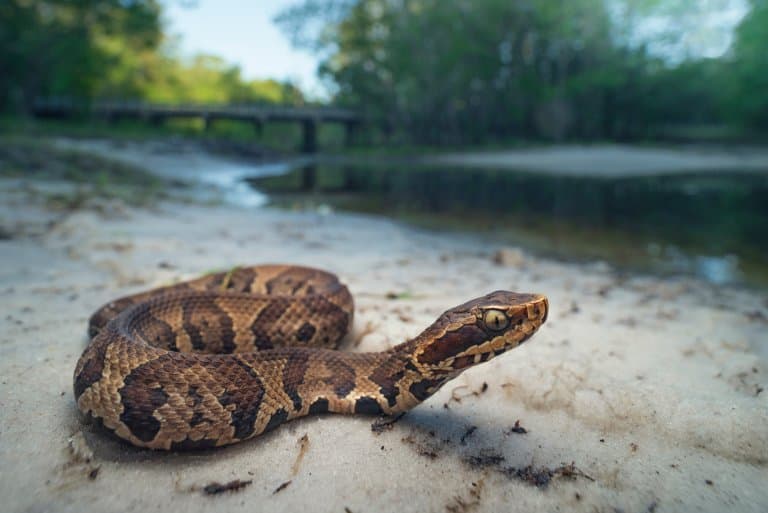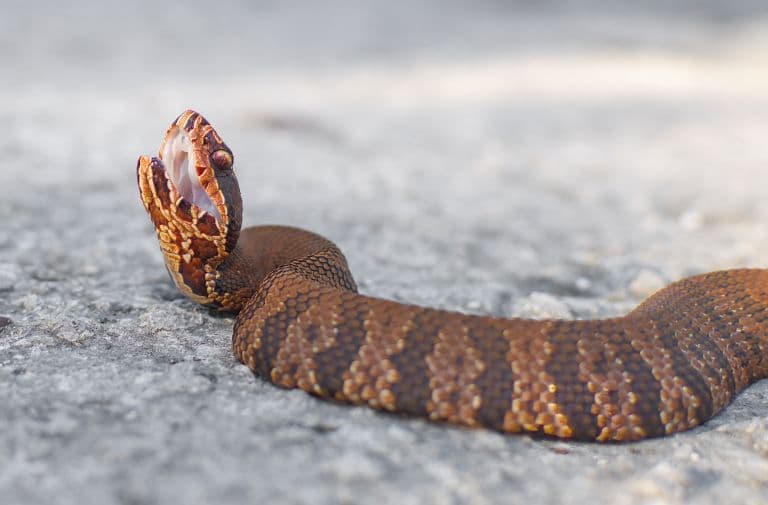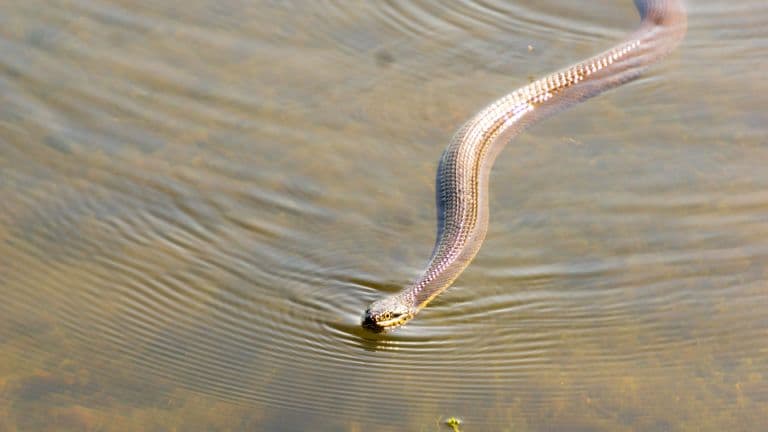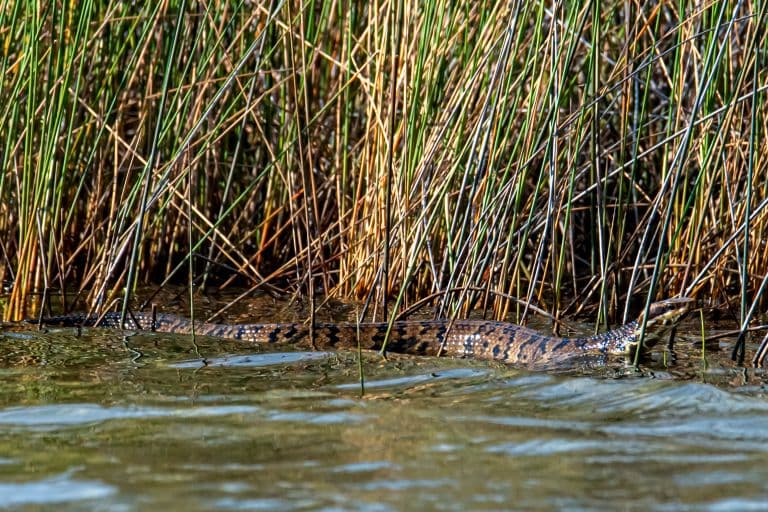Cottonmouth Profile
Of all the scary snakes in the hottest parts of North America, the cottonmouth sounds like the most pleasant. But this snake isn’t named for its lisp, it’s so-called because of a special gaping threat display that, if not heeded, can result in a dangerous altercation.
But like all snakes, this is another misunderstood animal, at the brutal end of humanity’s reluctance to face its fears sensibly. As such, it has a much more frightening reputation than reality can support.
The cottonmouth, Agkistrodon piscivorus, also known as the northern cottonmouth, ‘gaper’, water, swamp and black ‘moccasin’, is a semiaquatic, venoumous pit viper native to Southeastern USA.

Cottonmouth Facts Overview
| Habitat: | Wetlands, damp vegetation |
| Location: | North America, from Virginia and Missouri to Florida, Texas |
| Lifespan: | Up to around 25 years |
| Size: | 1.8m (74 inches) |
| Weight: | Usually 1.7kg (60 oz), top 4.6 kg (10 lb) |
| Colour: | Brown, black, or olive green |
| Diet: | Mostly fish and frogs, but also birds, mammals |
| Predators: | Snapping turtles, falcons, owls, raccoons, dogs, cats |
| Top Speed: | Unknown |
| No. of Species: | 1 |
| Conservation Status: | Least Concern (IUCN) |
Cottonmouths are vipers, but from a different family to the rattlers they share their space with.
Its species name means “fish-eater” and this snake lives up to that; living on the water’s edge, feeding mostly on fish and frogs.
It’s got some pretty dangerous venom but it is very hesitant to use it, and would rather flee if it can.
Still, its reputation for being dangerous has led to its persecution, and while the species is currently stable, its habitats aren’t.
Interesting Cottonmouth Facts
1. They’re semi-aquatic
This is a viper, like many of the most infamous snakes in the Southern states such as the diamondbacks and the other rattlers, but it’s one that spends much of its time in water.
Fish and frogs are their primary source of calories, but they will eat more or less anything around that size. Despite being semi-aquatic they’re actually a bit crap at hunting underwater and will miss most of the time if they are striking while submerged.
Instead, they corner fish by rounding them into shallows or exploiting drying pools of water, where fish and tadpoles become trapped.
They’re not all that fussy about where their food comes from, and will even feed on carrion sometimes; something that’s very unusual for a snake. They’ve been known to feed on the remains of prepared fish, discarded by fishing boats back into the water.
2. Cottomouth’s are more than capable swimmers
While they spend much of their time in the shallows of creeks, streams, swamps, ponds and lakes, they can venture much further.
Larger cottomouths have been reported to enter bays and swim between barrier islands.
3. They’re versatile
These snakes make use of many of their senses to adapt to a range of environments. They have decent hearing and tactile senses, but will also use keen eyesight to locate their prey.
Their sense of smell is the strongest, and they’ll use this to take in various information about their surroundings, which might explain why they are so bad at hunting underwater.
But this array of senses means that such an opportunistic feeder is comfortable during the day or night, and can be found year-round. 1
4. Their name is derived from their threat display
As with almost all snake species, the first line of defence for the cottonmouth is to flee. But if that’s not an option, it will present in a coil with its head back and its mouth wide open, showing a bright white palate, which lends the animal its name.
This isn’t an attempt to strike, rather it’s a simple display of what might happen if it does. The next line of defence is a powerful musk which can shoot out of its back end for up to 1.5 meters. They can also buzz the tip of their tails, though they are not in the same genus as the rattlesnakes.
Striking comes last, and will happen very fast. Their venom is a highly dangerous cytotoxin, though deaths are very rare.
The tissue damage can cause infection and lasting scars and in some cases even amputation, but it’s worth repeating that this is the last in a line of increasingly desperate attempts to protect itself, and the snake would much rather get away if it can. 2

5. They can smell of cucumber
Most bites come from cases where the snake has been stepped on. Its sedentary pose can lead it to be overlooked entirely and if the gape isn’t spotted, the poor animal might think it needs to escalate.
But as mentioned, it has a chemical line of defence between these two, and those who have experienced it say it’s immediately recognisable.
The smell that comes from an alarmed cottonmouth is said to smell a little like cucumbers, which isn’t as upsetting as you might think it needs to be, but inside its ecosystem, it’s a recognisable warning sign that you’re getting too close to a venomous animal. 3 4
6. Males will ‘combat dance’
The conflict-aversion of a cottonmouth stops at mating, when males will engage with one another in what is essentially a snake version of Capouera.
Male cottonmouths perform a ritual courtship combat dance, involving choreographed slithering and seductive tail waving, designed to lure females away from a competing male.
Males will also fight over mating rights, and are said to be monogamous.
7. They’re not very popular
Cottonmouths and humans have a deeply overlapping habitat as they both appreciate the water’s edge in regions where it’s rather hot.
This has made them a common snake to encounter and often in negative contexts, so they’ve got a bit of a reputation for being unpleasant. Still, bites are very rare, but try explaining that to a hysterical human who’s already afraid of wasps.
When defending, they typically inject less venom than they would for feeding, too, which gives the ignorant human a chance to get away intact.
At first glance, it might seem that people should be entitled to their fears, but the implications of these lead to deeper ecological problems when the animals aren’t granted the respect, they deserve to live undisturbed. 5

8. They have one of the fastest strike speeds
The cottonmouth was the second fastest snake measured for strike speed at 11.1 km/h or 6.9 mph.
While not all that good at grabbing fish underwater, they’ll corner them in drying pools to take a better shot. It’s safe to say that a fast strike speed is useful in this context. 6
9. Human deaths are rare from bites
While their venom is rich and powerful, but fortunately deaths are rare. Symptoms include swelling and pain in the area of the bite.
Their venom does not contain neurotoxic components like other snakes, instead it destroys tissue.
Their venom can cause scars, and occassionally require amputation. Bites can be treated using CroFab antivenom.
10. Their habitats are threatened
And so it is, the cottonmouth habitat is one that’s under threat and the species isn’t likely to gather widespread support.
Wetland drainage for agriculture is the big one, but commercial and residential development and killings by silly people also play a significant role.
The species isn’t threatened as of yet, and in fact its population is thought to be stable, but its habitats are threatened, so it’s only a matter of time before it runs out of places to live.

Cottonmouth Fact-File Summary
Scientific Classification
| Kingdom: | Animalia |
| Phylum: | Chordata |
| Class: | Reptilia |
| Order: | Squamata |
| Family: | Viperidae |
| Genus: | Agkistrodon |
| Species: | Agkistrodon Piscivorus |
Fact Sources & References
- Kimberly Andrews (Year), “Cottonmouth / Water Moccasin (Agkistrodon piscivorus) – Venomous”, University of Georgia.
- “Florida Cottonmouth”, Florida Museum.
- “Cottonmouth (Agkistrodon piscivorus)”, University of Georgia.
- (2023), “Cottonmouth snakes: Facts about water moccasins”, Science Direct.
- HOUSTON CHANDLER (2020), “The Cottonmouth Myth”, The Orianne Society.
- Marcus Woo (2016), “To Scientists’ Surprise, Even Nonvenomous Snakes Can Strike at Ridiculous Speeds“, Smithsonian Magazine.
